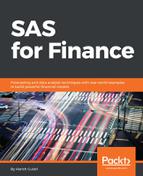In our business case, we realized that our fund manager wanted to identify clients who met the following criteria:
- Have been with the firm for a long time
- Are probably going to stay for a long time
- Are at risk of churn
- Continue to have AUM with the brokerage, and the reasons for this
Survival analysis models were run to try to understand how some of the business questions could be answered. Prior to that, we tried to gain an understanding of what survival analysis modeling is, the advantages it presents over other modeling types, and the various forms of the analysis techniques, namely parametric, semi-parametric, and non-parametric approaches. We also highlighted the differences between the frequentist and the Bayesian approach using PROC LIFEREG. The concept of Markov chains was also introduced in the chapter as part of the discussion on Cox models. To use these techniques, we discussed the need and the way to build censoring variables.
From a modeling output perspective, it is clear that the Cox proportional hazard parametric model has shown that some of the variables used in the other survival analysis approaches aren't fit for use in the current form. We would have to transform some of these variables (please see the output of Figure 6.15 for detailed discussions). Results from the non-parametric (PROC LIFETEST) and the parametric (PROC LIFEREG) procedure are quite similar and we can use either of the two models. However, as we discussed, there are differences in both these analytical techniques.
Looking at the data, we can answer the business question: who are the customers that have been with the brokerage organization for a long time? We now know the survival probability of our customers across their tenure. Using various covariates, we have been able to establish which among these are important and the degree of their influence on tenure, which is the key business metric we were trying to evaluate. These two pieces of information can help us identify the customers who may stay for a long time and identify those who are at immediate risk (based on their position on the survival curve). We now know the important covariates. We can evaluate each customer based on the role these covariates have played over the years. These can act as discriminatory factors and help understand why some customers continue to have AUM with the firm whereas others don't. Hence, using the survival technique, we can answer multiple questions that the business case posed.
In the next chapter, we will explore how financial institutions leverage market basket analysis and segment their customers using clustering techniques.
